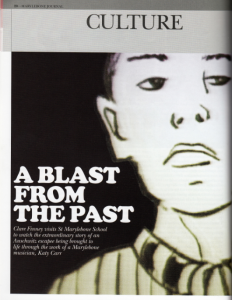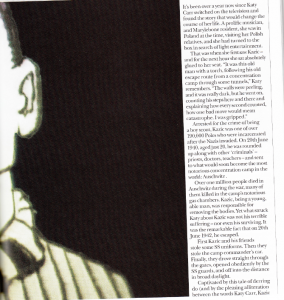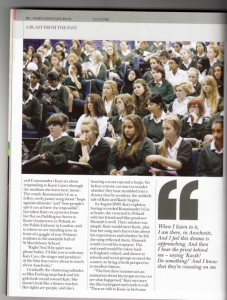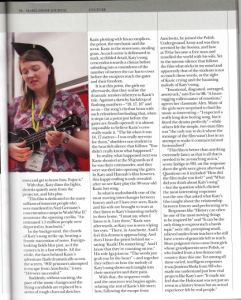It’s been over a year now since Katy Carr switched on the telly and found the story that
would change the course of her career. A prolific musician, and Marylebone resident, she
was in Poland at the time, visiting her Polish mother’s relatives, and she had turned to the
box in search of some light entertainment.
At first it seemed there was nothing on, and for some time Katy flicked idly from channel
to channel. Then she saw Kazic – and for the next hour she sat absolutely glued to her
seat.




“It was this old man with a torch, following his old escape route from a concentration
camp through some tunnels,” Katy remembers. “The walls were peeling, and it was really
dark: but he went on, counting his steps here and there and explaining how every second
counted, how one bad move would mean catastrophe. I was gripped.”
Arrested for being a boy scout, Kazic was one of over 190,000 Polish people to have
been incarcerated after the Nazis invaded. On 20th June 1940, aged just 20 years old,
Kazic was rounded up and sent along with other ‘criminals’ – priests, doctors, teachers –
to what would soon become one of the most notorious concentration camps in the world:
Auschwitz .
During those long years of German occupation, those who found themselves on the
wrong side of Hitler would suffer persecution on an unprecedented scale. In Auschwitz
alone over one million people died, or were killed in the camp’s notorious gas chambers
and shootings. Kazic, being a young, able man, was responsible for removing the bodies.
Yet what struck Katy about Kazic was not his terrible suffering – nor even his surviving.
It was the remarkable fact that on 20th June 1942 Kazic and his friends escaped.
First, explained the documentary, Kazic and his friends stole some SS uniforms. Then
they stole the Commanders car. Finally, they drove straight through the camp gates
(opened obediently by the SS guards) and off into the distance in broad daylight.
Captivated by this tale of derring do (and by the pleasing alliteration between the words
Katy Carr, Kazic and Commander) Katy set about responding to Kazic’s story in the
medium she knew best: music. The result, a folksy, eerily jaunty song about “hope
against adversity” and “how people’s spirit can achieve the impossible”, has been the
keynote of a mission that has taken Katie from her flat on Paddington Street, to Kazic’s
hometown in Poland, and back again to where we are standing now: in front of a gaggle
of year 9 history students in the assembly hall of St Marylebone School.
“Right! You’ll be quiet now please ladies. I’d like you to welcome Katy Carr, the singer
and producer of the film that you’re about to watch about Auschwitz.”
Gradually the chattering subsides, as Miss Marple steps back and the girls look round
toward Katy. She doesn’t look like a history teacher. Her tights are purple, and she’s
bearing a scout cap and a banjo. Yet before anyone can start to wonder whether they have
stumbled into Drama by accident, the unlikely tale of Katy and Kazic begins.
In August 2009 Katy explains, having recorded “Kazic and the Kommanders Car” at
home, she returned to Poland with her friend and film producer Hannah Lovell. Their
mission was simple: Katy would meet Kazic, play him her song and chat to him about
his experiences and whether he felt the song reflected them. Hannah would record his
response. The end result would be taken back to England, edited, and shown to schools
and scout groups around the country to bring a fresh perspective on people like Kazic.
“The first three minutes are an animation about his escape so you can see what
happened,” Katy says once the film is prepped and ready to roll. “Then we talk to Kazic
in his home town and get to know him. In total it’s about 23 minutes long. Enjoy it.”
With that, Katy dims the lights, shrinks quietly away from the projector, and hits ‘play’.
“This film is dedicated to the many millions of innocent people who were murdered in
Nazi Germany’s concentration camps in World War II” announces the opening credits.
“An estimated 1.5 million people were deported to Auschwitz.”
In the background Katy’s chords stroke up, beating a frantic succession of notes. Foreign-
looking fields blur past, as if the camera is in a fast vehicle. All the while, the facts
behind Kazic’s adventure flash dramatically across the screen. “802 prisoners attempted
to escape from Auschwitz,” it says. “144 were successful.”
Suddenly, without warning, the pace of the music changes and the flying cornfields are
replaced by a series of rough charcoaled sketches. Kazic plotting with his accomplices,
the priest, the mechanic and the scout. Kazic in the storeroom, stealing guns. As each
scene is delineated in stark, scribbled detail, Katy’s song crescendos towards a climax
before subsiding into a countdown of the number of metres the car has to cover before the
escapees reach the gates and their freedom.
It is at this point, the girls say afterwards, that they realise the dramatic tension inherent
to Kazic’s tale. Against a sketchy backdrop of flashing numbers – “18, 17, 16” and so on
– the song’s rhythm beats with such relentless foreboding that, when it stops (at a point
just before the gates are finally opened) it is almost impossible to believe Kazic’s crew
really made it. “The bit when it was 18, 17 metres -– I was really nervous for them,”
shudders one student in the heartfelt silence that follows. “You didn’t really know what
happened.”
In reality, what happened next was Kazic shouted at the SS guards as if he was their
commander, and they were startled into opening the gates. In Katy and Hannah’s film
however, this happy ending is only revealed after we see Katy play the 90-year-old Kazic
her song.
In what is undoubtedly one of the most moving interchanges between history and art I
have ever seen, Kazic and his wife are brought to tears as they listen to Katy’s haunting
melody in their home. “I must say, when I listen to it, I am there,” Kazic says afterwards,
as Katy too is seen wiping her eyes. “There, in Auschwitz. And I feel this drama is
approaching. And then I hear the priest behind me – saying ‘Kazik! Do something!’ And
I know that they’re counting on me.” His wife Iga joins in -“the words just grab you by
the heart” – and together they reflect on how the melody of Katy’s song shows such
insight into their memories and their pain.
With that, the sequence ends and the onscreen text begins again, relating the rest of
Kazic’s life story: how, following the escape from Auschwitz, he joined the Polish
Underground Army and was then arrested by the Soviets, and how at 70 he became a free
man and travelled the world with his wife. Yet in the audible silence that follows the film
what sticks in my mind and apparently that of the students is not so much these words, as
the sight of Kazic crying and the haunting, catchy melody of Katy’s song.
“Emotional, disgusted, outraged, awestruck,” says Eve in 9B. “A heart-tugging
rollercoaster of emotions,” agrees her classmate Alex. Many of the girls were surprised
to find the music so interesting – “I expected a really long slow boring song, but it fitted
the drama perfectly” – while others felt the simple, two-man film was “the only way to
do it where the message of the film wasn’t lost in an attempt to make it commercial and
fictionalized.”
“This film is better than anything extremely fancy as that is all that is needed to be
as touching as it is,” wrote Indigo in 9H, on the response sheet the girls were given
afterward. Questions on it included “How did the film make you feel?” and what did you
think about Katy’s song” -– but the question which elicited the most interesting responses
was that which asked what Katy’s film taught about the relationship between history and
performing arts.
Responses like “History can often be one of the most moving things be inspired by”
and “It can be the only thing to express such a harsh topic” were rife, prompting small,
relieved smiles from teachers who still have a term of genocide left to teach. More
poignant views came from girls whose grandparents were Polish, or who hailed from a
less democratic country than this one. Yet among all these varied, intelligent responses it
was Jemima Shola from 9H who made me understand just how vital projects like Katy’s
are: “It made me feel that the Holocaust was not just an event in a history lesson but an
actual experience felt by real people.”
